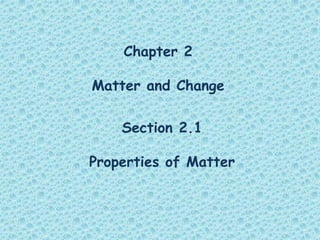
Chapter 2
- 1. Chapter 2 Matter and Change Section 2.1 Properties of Matter
- 2. Matter has extensive and intensive properties. Extensive property is a property that depends on the amount of matter in a sample. e.g. mass and volume Mass is a measure of the amount of matter the object contains. Volume is a measure of the space occupied by the object. Intensive property is a property that depends on the type of matter in a sample, not the amount of matter. e.g. hardness, temperature, pressure, density, & solubility. Matter that has a uniform and definite composition is called a substance.
- 3. Physical Property e.g. malleability, color, hardness and conductivity. is a quality or condition of a substance that can be observed or measured without changing the substance’s composition. Every sample of a given substance has identical intensive properties because every sample has the same composition. States of Matter Particles are packed closely together Particles are packed closely together but they are free to flow past one another Particles are relatively far apart and can move freely Solid Liquid Gas Definite shape Indefinite shapeIndefinite shape Definite volume Definite volume Indefinite volume Not easily compressed Easily compressedNot easily compressed
- 4. e.g. boiling, evaporation, freezing, melting, and condensing. These characteristics are said to be reversible physical changes because a substance can be reformed again to its original shape. While cutting, breaking, splitting, crushing, and grinding are irreversible physical changes. If the appearance of the matter changes without changing its composition, it is called physical change. Vapor is a word that describes the gaseous state of a substance that is generally a liquid or solid at room temperature. e.g. water vapor
- 5. Phase Changes Solid Liquid Gas Melting Vaporization CondensationFreezing
- 7. Vaporization is a transitional phase of an element or compound from a liquid phase to a gas phase. Vaporization has two types: Boiling, wherein the transition from liquid phase to gas phase takes place at or above the boiling temperature, and it occurs below the surface. Evaporation, wherein the transition from liquid phase to gas phase takes place below the boiling temperature at a given pressure, and it occurs on the surface.
- 9. What is a Mixture ?? is a physical blend of two or more components, e.g. air, juice, sea water, milk, sand and water…etc. Homogeneous mixture is a mixture in which the composition is uniform throughout. Heterogeneous mixture is a mixture in which the composition is not uniform throughout. e.g. sand with water, oil and water. e.g. table salt and water, milk, coke. These mixtures have another name which is, Solutions A mixture with more than one phase. A mixture consists of one phase.
- 10. How can we separate mixtures?? The best way for separation, solid from the liquid in heterogeneous mixtures is filtration. But if we have liquid with a solid dissolves in, like salt and water (homogeneous mixture), we have to use a process called, distillation.
- 11. Go to page : 47 Classwork Page: 47, # 14
- 12. Section 2.3 Elements and Compounds
- 13. Element is the simplest form of matter that has unique properties. Compound e.g. sodium (Na), hydrogen (H) is a substance that contains two or more elements chemically combined together. Compounds can be broken into simpler substances but elements cannot. If the composition of a matter changed into a new matter different than the original one, it is called chemical change. e.g. sodium chloride (NaCl)
- 14. Classwork: Page: 52, # 24, 25, & 26
- 16. Chemical property is the ability of a substance to undergo a specific chemical change. During a chemical change, the composition of matter always changes. iron + sulfur iron sulfide reactant product a substance at the start of the reaction a substance produced in the reaction
- 17. During any chemical reaction, the mass of the products is always equal to the mass of the reactants The Law of Conservation of Mass states that in any physical change or chemical reaction, mass is conserved. Mass is neither created nor destroyed. e.g. If 10 grams of carbon reacts with 5 grams of oxygen gas, 15 grams of carbon oxide is produced.
- 18. How can you tell whether a chemical change has taken place? There are four possible clues to chemical change: o a transfer of energy o a change in color o producing a gas o forming a precipitate a solid that forms and settles out of a liquid mixture.
- 19. Classwork: Page: 55, # 31, 32, & 34